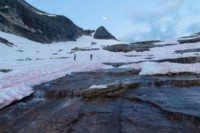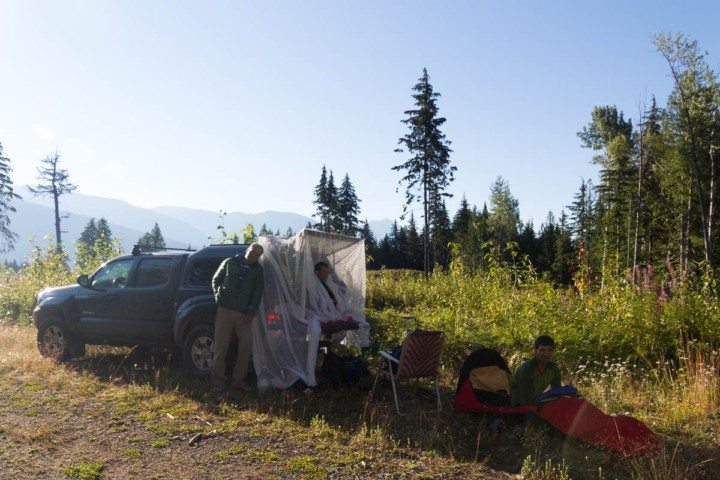This summer, three Nelson men accomplished a world first by running, scrambling and bush-bashing the entire length of British Columbia’s Valhalla Provincial Park, from south to north, in under 24 hours. That’s about 52 kilometres over six mountain passes – in a day! Ultra-runner Randy Richmond shares the story of their adventure.
By Randy Richmond
Photos by Nelson Rocha
July 16, 2016, Kootenay Mountain Culture magazine
Bucket lists can be great motivators, providing a spiritual launch forward to fill up a “life’s cup” of journeys. For four years, I had to keep moving my summer Valhalla traverse adventure onto next year’s list – maybe with sound unconscious reasoning. I’m approaching my mid-50s, so the pain and suffering are no longer masked by adrenaline; instead, I am left with good ol’ basic nervousness. Well, fear.
The date was July 23, 2016, and the sun was setting as our vehicle slowly rounded the corner of the rough Hoder Creek forest service road. Suddenly, two majestic cougars came into view, looking startled, before quickly disappearing into the dense bush – the same bush we were going to be running through in a few short hours.
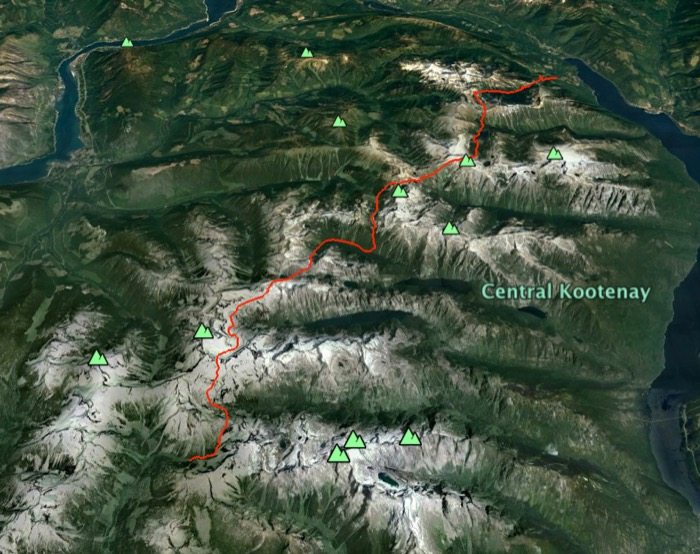
The trio’s route through the Valhalla Provincial Park.
By the time we got to our southern access point in Valhalla Provincial Park, it was well past dark, so I lay down on the ground to try and get some sleep. I’m not sure if it was the cougars or the anticipation of what was in store, but shut-eye never came. So I cancelled my alarm and jealously woke my friends out of a deep sleep at 2:30 am.
There are not too many buddies who can get excited about a fast traverse of the entire Valhalla mountain range in one go, but Chris Rowat and Nelson Rocha never even batted an eye when I suggested it. There are no trails once you access the heart of the Valhallas, except the first few kilometres to Gwillam Lakes, and we’d need to cross six mountain passes before descending into Wragge Lake and out to the junction of Shannon Creek FSR just above the town of Hills on the northern end of Slocan Lake.
We estimated 15-18 hours for the entire traverse, but calculating travel time through the mountains, especially without any trails, is a wild ass guess at best.
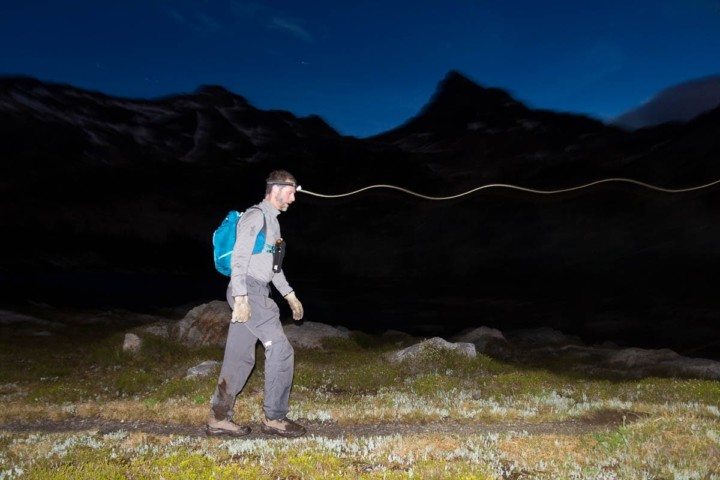
Chris Rowat leads the charge into the mountains.
• Chris led the charge at 2:30 am Saturday, and we gained 900 metres to the first pass, Lucifer Col, in two hours. We were rewarded with a spectacular sunrise followed by a fun “shoe ski” descent down the north-facing snow-filled slope.
Navigating steep snow slopes near the Lucifer col
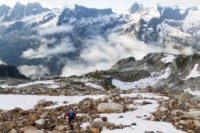
Hiking up towards the east shoulder of Urd Peak with the Devil’s Range in the background.
We made significant progress over the first three mountain passes, and we soon came to appreciate that travelling south to north was the best choice because it provided us with dry rock on the southern aspects, followed by the north slopes still filled with snow, which made for quick descents.
• As we rounded Demers Peak and started descending into the next valley, it became apparent our speedy travel was about to come to an abrupt halt. At 1,600 metres, we were no longer in the alpine and instead had to deal with thick forest, bushy alder slide paths and marshy creeks. We had long given up worrying about wet feet as we trudged direct lines through the marshes to avoid the alder. We spoke seldom except to discuss route options, and it took us four hours to cover that one valley.
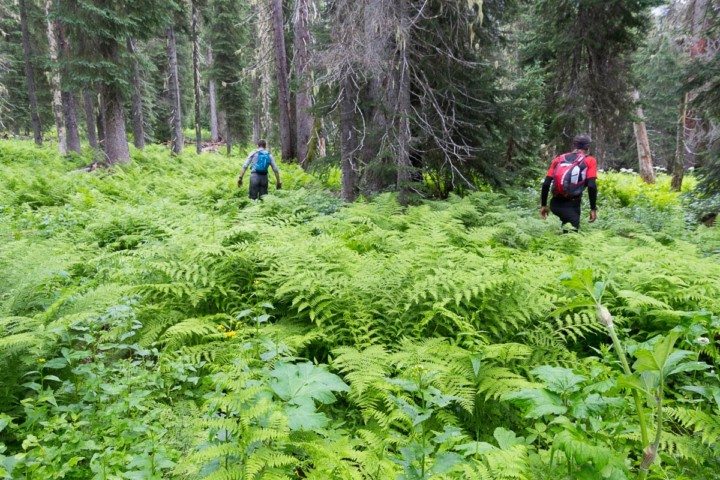
The first bushwalk after Beatrice Creek.
• We then traversed around Hela NW4 Peak and up Mount Meers, and it was getting late in the day when we spotted Wee Sandy Lake and our sixth and final climb up the Skadi col.
\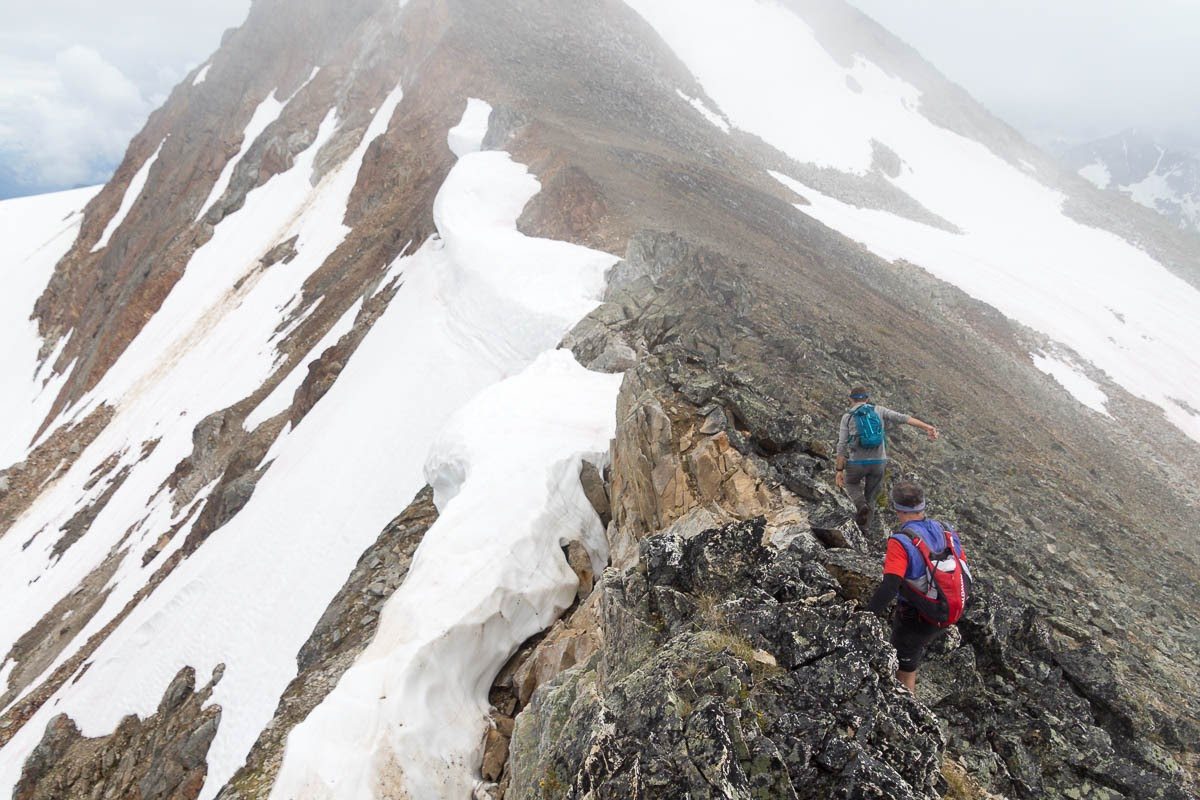
Running along the Mt. Meers ridge to try and find a way down from the pass.
Our estimation of a 15- to-18 18-hour traverse was now out the window, and weak thoughts started creeping into my consciousness. “If I just twisted my ankle, a helicopter rescue would end this suffering,” I thought. And “Maybe we should camp here and get going tomorrow.” This wasn’t my first rodeo, though, and I knew what to do. I glanced over at Chris and Nelson, and they too were showing signs of fatigue, and I muttered, “Water break time.” I then pulled out my emergency pouch and grabbed a can of Coke. I’d been lugging it around for 17 hours, but it was worth it: I drained it all in one go. It only took a few seconds to feel that heavenly rush of sugar flowing through my veins. I was powerful once again.
• The bush was so thick around Wragge Lake that it was faster to wade through the waist-deep water along the shoreline. We gained the last climb just as daylight ran out and then braced ourselves for the challenges that total darkness would bring for the final descent. I thought of a quote from Joseph Conrad: “There it is before you, smiling, frowning, inviting, grand, mean, insipid, or savage, and always mute with an air of whispering, ‘Come and find out.’”
The terrain became steeper, and we were almost free-falling down the mountainside, barely averting disaster by grappling the alder bushes. Light was limited to our headlamps, which only illuminated a few feet in front of us, and route finding became nearly impossible. One wrong step and we’d launch ourselves off a cliff. Finally, Nelson found the one little gap through the steep terrain, but it led us to another slope filled with Devil’s Club, a spiky, poisonous plant that we tripped and tumbled through.
After what seemed like forever, we reached the 500-meter-long Wragge Lake, but our ordeal was not yet over. Those 500 meters took us an hour to navigate! That works out to eight metres per minute, and we were going hard, but the darkness and lack of food had taken their toll. We were now 22 hours into our “fun traverse,” and I again started to think about Joseph Conrad’s novel and how Charlie Marlow penetrated deeper and deeper into the heart of darkness.
• Finally, we stumbled onto the old trail leading out of Wragge Lake, looking like a pack of zombies. With one last push, we made quick progress down the FSR to our truck. We said we wanted to do this whole traverse in a day, and when I looked at my watch, it read 23 hours and 58 minutes. I was too nauseous to eat and too tired to lie my sleeping pad on the ground, so I crawled into the front seat, pulled my sleeping bag over my head, and drifted off thinking once again about the Heart of Darkness and our journey through the Valhallas. “It was like travelling back to the earliest beginnings of the world, when vegetation rioted on the earth and the big trees were kings. An empty stream, a great silence, an impenetrable forest.”
Their Mistakes (Ron Perrier)
They did well until leaving Demers Lake and coming off Demers Peak – a long ridge with two bumps, the most westerly on the watershed. Instead of starting a long bushwhack, they should have stayed on the ridge line for the next 1.5 km, descending at 493 273 into the alpine and contouring above Avis Lakes.
Getting around Hela Peaks (at least four summits on a long 3.5km ridge with the most westerly on the watershed) is usually done by descending to the west and traversing around this rugged ridgeline. This posed no issues for them.
They should have stayed on the ridge above Wee Sandy Lake, go over the summit of Mt Niord—no reason to go down to the lake.
Their major mistake was the descent out past Wragge Lake, a disastrous bushwhack. Much easier to continue on the ridge between Mt Skadie and One Goat Pass (Mt Vingolf) and descend to Shannon Lake, the Shannon Lake Trail and their parked car.
